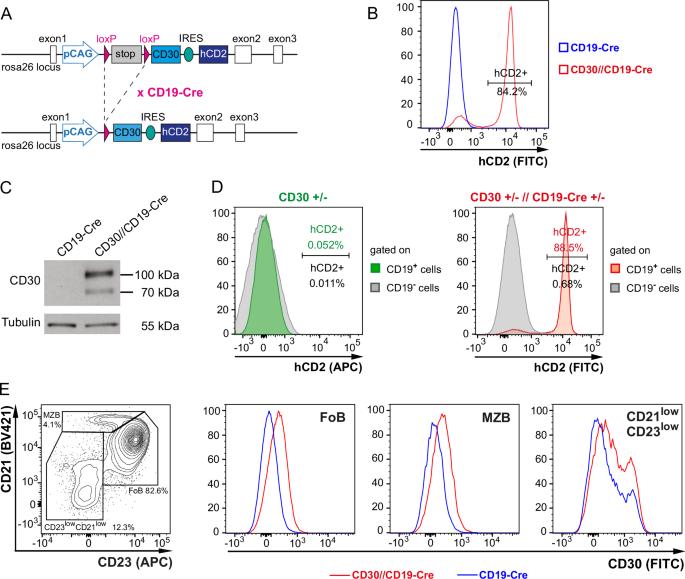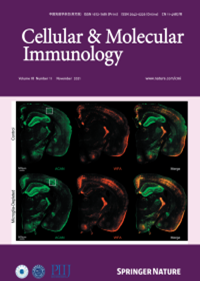CD30 influences germinal center B-cell dynamics and the expansion of IgG1-switched B cells
IF 19.8
1区 医学
Q1 IMMUNOLOGY
引用次数: 0
Abstract
Initially, identified as a Hodgkin lymphoma marker, CD30 was subsequently detected on a subset of human B cells within and around germinal centers (GCs). While CD30 expression is typically restricted to a few B cells, expansion of CD30-expressing B cells occurs in certain immune disorders and during viral infections. The role of CD30 in B cells remains largely unclear. To address this gap in knowledge, we established a conditional CD30-knockin mouse strain. In these mice, B-cell-specific CD30 expression led to a normal B-cell phenotype in young mice, but most aged mice exhibited significant expansion of B cells, T cells and myeloid cells and increased percentages of GC B cells and IgG1-switched cells. This may be driven by the expansion of CD4+ senescence-associated T cells and T follicular helper cells, which partially express CD30-L (CD153) and may stimulate CD30-expressing B cells. Inducing CD30 expression in antigen-activated B cells accelerates the GC reaction and augments plasma cell differentiation, possibly through the posttranscriptional upregulation of CXCR4. Furthermore, CD30 expression in GC B cells promoted the expansion of IgG1-switched cells, which displayed either a GC or memory-like B-cell phenotype, with abnormally high IgG1 levels compared with those in controls. These findings shed light on the role of CD30 signaling in GC B cells and suggest that elevated CD30+ B-cell numbers lead to pathological lymphocyte activation and proliferation.

CD30 影响生殖中心 B 细胞的动态和 IgG1 开关 B 细胞的扩增。
CD30 最初被认为是霍奇金淋巴瘤的标志物,后来在生殖中心(GC)内部和周围的人类 B 细胞亚群中被检测到。虽然 CD30 的表达通常仅限于少数 B 细胞,但在某些免疫紊乱和病毒感染时,会出现表达 CD30 的 B 细胞扩增。CD30 在 B 细胞中的作用在很大程度上仍不清楚。为了填补这一知识空白,我们建立了一个条件性 CD30 基因敲除小鼠品系。在这些小鼠中,B 细胞特异性 CD30 表达导致年轻小鼠的 B 细胞表型正常,但大多数老年小鼠的 B 细胞、T 细胞和髓系细胞显著扩增,GC B 细胞和 IgG1 切换细胞的百分比增加。这可能是由 CD4+ 衰老相关 T 细胞和 T 滤泡辅助细胞的扩增驱动的,这些细胞部分表达 CD30-L(CD153),并可能刺激表达 CD30 的 B 细胞。诱导抗原激活的 B 细胞表达 CD30 可加速 GC 反应并促进浆细胞分化,这可能是通过转录后上调 CXCR4 实现的。此外,GC B 细胞中 CD30 的表达促进了 IgG1 切换细胞的扩增,这些细胞显示出 GC 或记忆样 B 细胞表型,与对照组相比,其 IgG1 水平异常高。这些发现揭示了 CD30 信号在 GC B 细胞中的作用,并表明 CD30+ B 细胞数量升高会导致病理性淋巴细胞活化和增殖。
本文章由计算机程序翻译,如有差异,请以英文原文为准。
求助全文
约1分钟内获得全文
求助全文
来源期刊
CiteScore
31.20
自引率
1.20%
发文量
903
审稿时长
1 months
期刊介绍:
Cellular & Molecular Immunology, a monthly journal from the Chinese Society of Immunology and the University of Science and Technology of China, serves as a comprehensive platform covering both basic immunology research and clinical applications. The journal publishes a variety of article types, including Articles, Review Articles, Mini Reviews, and Short Communications, focusing on diverse aspects of cellular and molecular immunology.

 求助内容:
求助内容: 应助结果提醒方式:
应助结果提醒方式:


